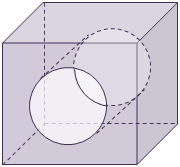A cube with a cyndrical hole cut out of the middle of the cube is shown. The edge length of the cube is 12 meters, and the circle on the front face of the cube has a diameter of 4 feet. Find the surface area of the figure.

Sometimes, you will need to find the surface area of a composite figure when a piece of a 3-dimensional figure has been removed.
A cube with a cyndrical hole cut out of the middle of the cube is shown. The edge length of the cube is 12 meters, and the circle on the front face of the cube has a diameter of 4 feet. Find the surface area of the figure.

The steps needed to find the exposed surface area of the figure are:
 .
. is the hole on the face of the cube, and how many holes are there?
is the hole on the face of the cube, and how many holes are there?
 of the holes.
of the holes. do you need to perform to remove the area of the holes?
do you need to perform to remove the area of the holes? .
. is an exposed surface inside the cube?
is an exposed surface inside the cube? of the cylinder.
of the cylinder. the lateral area of the cylinder to the surface area of the cube without the holes.
the lateral area of the cylinder to the surface area of the cube without the holes.It is worth noting that there are other ways you could have worked this problem. The important part is that you are sure that all surfaces that are exposed have been counted, and any removed surfaces—or removed parts of surfaces—have been subtracted.